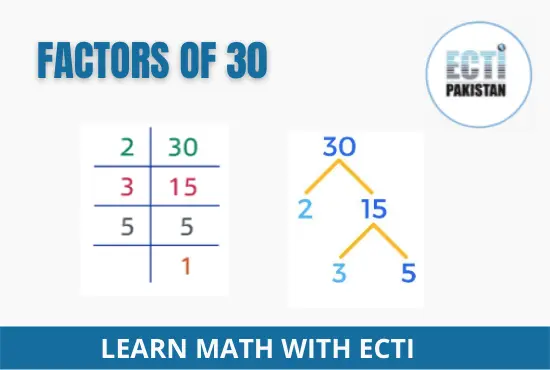Factors Of 30 | With Easy Division and Prime Factorization

Contents
Factors Of 30
The numbers that, when multiplied together in pairs of two, give the result of 30, are called Factors of 30. Factors are also considered numbers that divide a number completely, leaving zero as the remainder.
30 cannot be divided by a decimal or fraction, but the factors can be positive or negative. For example, factor 30 could be (1, 30) or (-1, 30). If we multiply a pair of negative numbers, for example, multiplying -1 and -30, it will yield an original number of 30.
Using the division and prime factorization methods, we will learn the pair factors and prime factors of 30.
What are the Factors of 30?
Numbers that divide 30 exactly without leaving a remainder are called factors of 30. The number 30 has factors other than 1 and 30 since it is an even composite number.
Consequently, the factors of 30 are 1, 2, 3, 5, 6, 10, 15, and 30.
Factors of 30: 1, 2, 3, 5, 6, 10, 15 and 30.
Prime Factorization of 30: 2 × 3 × 5

Factors Of -30
Factors of -30: -1, -2, -3, -5, -6, -10, -15 and -30.
We can get -30 by having (-1, 30), (-2, 15), (-3, 10), and (-5, 6) as a pair of factors. Similarly, we can also get -30 by having (1, -30), (2, -15), (3, -10), and (5, -6) as a pair of factors.
Pair Factors of 30
The pair factors of 30 are two numbers multiplied to result in the original number 30. Both positive and negative pair factors will result in the actual number 30. Here are the positive and negative pair factors of 30.
Positive Pair Factors of 30:
| Positive Factors of 30 | Positive Pair Factors of 30 |
| 1 × 30 | (1, 30) |
| 2 × 15 | (2, 15) |
| 3 × 10 | (3, 10) |
| 5 × 6 | (5, 6) |
Negative Pair Factors of 30:
| Negative Factors of 30 | Negative Pair Factors of 30 |
| -1 × -30 | (-1, -30) |
| -2 × -15 | (-2, -15) |
| -3 × -10 | (-3, -10) |
| -5 × -6 | (-5, -6) |
Accordingly, the positive pair factor of 30 is (1, 30), (2, 15), (3, 10) and (5, 6), and the negative pair factor of 30 is (-1, -30), (-2, -15), (-3, -10) and (-5, -6).
Factors of 30 by Division Method
In the division method, we will find the factors of 30 by dividing the number by different integers. Integers that divide 30 exactly are factors of 30. Here we will go over how to find the factors of 30 using the division method.
Start by dividing 30 by 1 and continue with the consecutive integers.
- 30/1 = 30 (Factor = 1 and Remainder = 0)
- 30/2 = 15 (Factor = 2 and Remainder = 0)
- 30/3 = 10 (Factor = 3 and Remainder = 0)
- 30/5 = 6 (Factor = 5 and Remainder = 0)
- 30/6 = 5 (Factor = 6 and Remainder = 0)
- 30/10 = 3 (Factor = 10 and Remainder = 0)
- 30/15 = 2 (Factor = 15 and Remainder = 0)
- 30/30 = 1 (Factor = 30 and Remainder = 0)
You leave a remainder if you divide 30 by any number other than 1, 2, 3, 5, 6, 10, 15, and 30. In other words, the factors of 30 are 1, 2, 3, 5, 6, 10, 15, and 30.

Prime Factorization of 30
In mathematics, the number 30 is a composite. Now we will find its prime factors.
- To begin, divide 30 by the smallest prime number, 2.
30 ÷ 2 = 15
- Once again, divide 15 by 2.
15 ÷ 2 = 7.5; not a fraction.
- Next, divide 15 by the next prime number, i.e., 3.
15 ÷ 3 = 5
- We get a fraction number when dividing 5 by 3, which isn’t a factor.
- So let us move on to the next prime number, which is 5.
5 ÷ 5 = 1
- Since we have received 1 at the end, we can no longer use the division method. In other words, the prime factorization of 30 is 2 × 3 × 5, where 2, 3, and 5 are the prime numbers.
Examples
Example 1:
Determine 30 and 32’s common factors.
Solution:
1, 2, 3, 5, 6, 10, 15, and 30 are the factors of 30.
Factors of 32=1, 2, 4, 8, 16, and 32.
Hence, 30 and 32 have common factors, 1, and 2.
Example 2:
Find the common factor between 72 and 26.
Solution:
The factors of 72 are 1, 2, 3, 4, 6, 8, 9, 12, 18, 24, 36, and 72.
The factors of 26: 1, 2, 13 and 26
Thus, 72 and 26 have a common factor of 1 and 2.
Example 3:
Calculate the common factor of 24 and 15.
Solution:
The factors of 24 are 1, 2, 3, 4, 6, 8, 12, and 24.
15 has factors 1, 3, 5, and 15.
Therefore, 24 and 15 have the following common factors: 1 and 3.
FAQs
How many factors are there in 30?
1, 2, 3, 5, 6, 10, 15, and 30 are the factors of 30.
The prime factorization of 30 is?
The factorization of 30 is 2 × 3 × 5.
How many positive pair factors does 30 have?
30 has four positive pair factors: (1, 30), (2, 15), (3, 10), and (5, 6).
How many negative pair factors does 30 have?
Negative pair factors of 30 are (-1, -30), (-2, -15), (-3, -10), and (-5, -6).
Is 15 a factor of 30?
15 is indeed a factor of 30. Since 15 divides 30 without leaving a remainder, 15 is a factor of 30.
Also Read:
Factors of 15=1, 3, 5, and 15.
Factors of 36=1, 2, 3, 4, 6, 9, 12, 18, and 36.
Factors of 24 = 1, 2, 3, 4, 6, 8, 12, and 24.
Factors of 42= 1, 2, 3, 6, 7, 14, 21, and 42.
Factors of 62=1, 2, 31, and 62.
Factors of 32=1, 2, 4, 8, 16, and 32.
Factors of 27=1, 3, 9, and 27.
